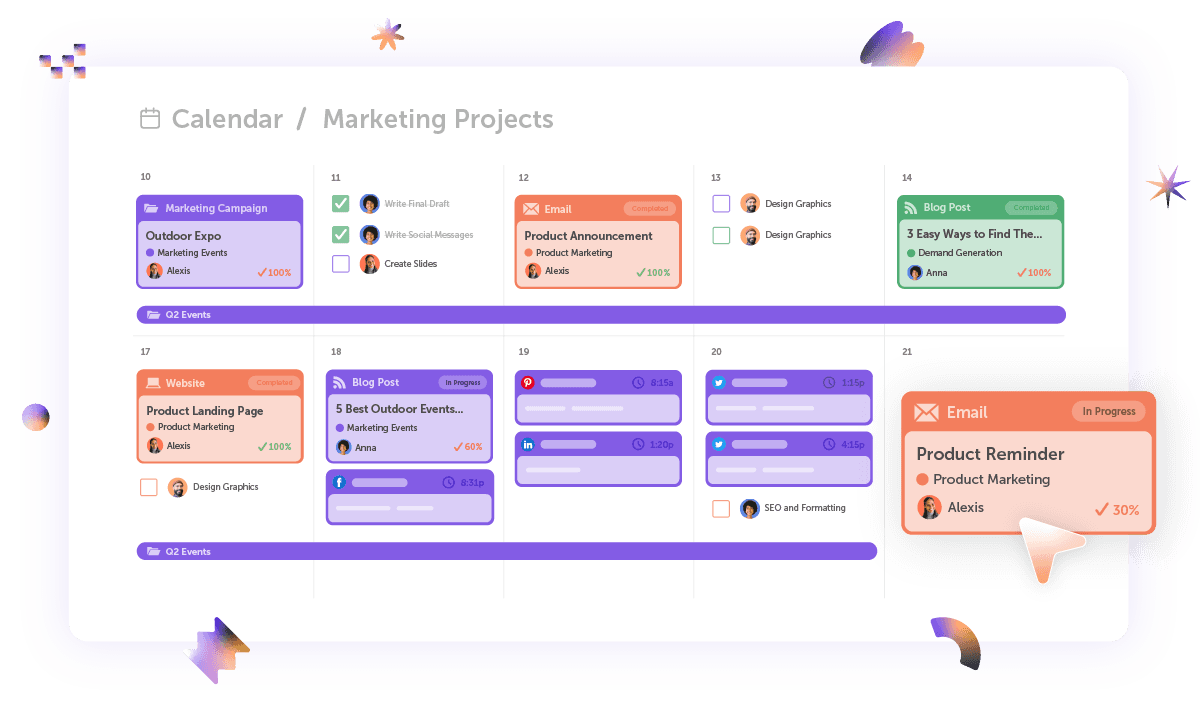Launching a new product is no small feat. Believe me, I've been in the trenches! After my mediocre attempts to introduce a couple startups years ago, I started digging into why some product launches wildly succeed while others fade into obscurity.
I realized it often came down to preparation and planning. The companies with the most strategic blueprints tended to connect with audiences immediately while achieving explosive growth shortly after launch. I made it my mission to crack the code on their methods so I could help other founders replicate their results.
After now guiding numerous startups on successful launches that led to 7 and 8 figure businesses, I created this comprehensive checklist so more entrepreneurs can benefit from what I wish I knew way back when. It covers the essential ingredients across strategy, positioning, marketing, and execution needed to give your product lift off on day one.
Consider it your blueprint for entering the ring prepared to land knockout punches that thunderously announce your arrival. Let’s get started!
Product Launch Marketing Checklist
Pre-Launch Planning
- [ ] Conduct competitor analysis
- [ ] Create detailed buyer personas
- [ ] Define market size and opportunity
- [ ] Set measurable goals and key results
- [ ] Outline positioning and messaging framework
- [ ] Determine required budget and resources
- [ ] Build integrated campaigns calendar
- [ ] Select marketing analytics tools
Website & Content Creation
- [ ] Implement branding guidelines
- [ ] Develop information architecture
- [ ] Create primary value proposition pages
- [ ] Produce blog posts and guides
- [ ] Expand site content and keywords over time
- [ ] Optimize pages for conversions
- [ ] Configure analytic event tracking
Go-To-Market Activation
- [ ] Brief influencers, analysts, press
- [ ] Create asset kits and exclusive offers
- [ ] Seed content in key communities
- [ ] Run paid social and retention campaigns
- [ ] Activate launch PR plan
- [ ] Drive referrals and ambassador networks
Post-Launch Follow-Up
- [ ] Measure performance across growth metrics
- [ ] Survey for testimonials and case studies
- [ ] Uncover expansion opportunities
- [ ] Build customer community and feedback loops
- [ ] Develop retention and expansion playbooks
- [ ] Track health scores and optimize as needed
Pre-Launch Preparations
Competitor Analysis Framework
| Competitor | Positioning | Pricing | Key Features | Messaging Focuses |
|---|---|---|---|---|
| Calendly | Scheduling for small teams | Freemium to $8/month | Link scheduling, integrations, analytics | Saving time for faster growth |
| Doodle | Scheduling made simple | Free to $10/month | Polls, group decisions, calendar automation | Group productivity platform |
| ScheduleOnce | Appointment scheduling | $15+/month | Custom booking pages, payment processing, calendar syncing | Professionalism and customization |
| Acuity | Online appointment scheduling | $15+/month | Calendar syncing, payment processing, email reminders | Making client management easy |
Market Research and Target Audience Analysis
The first step is understanding the competitive landscape by analyzing your top competitors. Examine factors like positioning, pricing, features, and messaging. This will help you find gaps in the market and opportunities to differentiate. For example, when Calendly launched, scheduling tools existed but there were few solutions focused specifically on the SMB sales process. Their messaging spoke directly to “revenue teams" and they carved out a unique niche.

You also need to intimately understand your target customers using buyer personas. Map out details regarding challenges, goals, objections, preferred content formats, media consumption habits, etc. This will allow you to craft tailored messaging and choose the right marketing channels. For instance, when launching a productivity app for developers, you’d want to connect heavily with specific communities like HackerNews and utilize technical content since that matches the audience’s preferences.
Setting Clear Goals and Objectives
The next component is setting SMART goals - Specific, Measurable, Achievable, Relevant, and Time-bound. Rather than vague objectives like “build awareness”, define tangible goals like “achieve 8000 monthly active users with $120k in annual recurring revenue within the first year". This focuses efforts and allows accurate evaluation later on.

Building Your Product Launch Marketing Plan
Key Components of an Effective Marketing Plan
An effective marketing plan has several key components:
Situational Analysis: Cover competitor analysis, market trends/size, customer analysis from previously discussed research
Goals/KPIs: Outline specific measurable goals and key performance indicators based on milestone timeframes
Target Audiences: Detail the buyer personas which represent your most likely early adopters
Positioning Statement: Summarize what makes your product unique and why buyers should care
Messaging Framework: Map out messaging pillars and a messaging calendar aligned to the buyer’s journey
Campaigns Calendar: Provide an overview of planned campaigns across channels and timeframes
Budget/Resources: Define budgets for aspects like media spend and team members required for execution
Timeline and Milestones for a Smooth Launch
Generally, you want your marketing plan to map major activities over a 6-12 month runway leading up to launch. Key pre-launch milestones should include:
6 Months Out: Complete brand messaging framework and foundational website pages
4 Months Out: Release teaser content to build anticipation, collect email sign-ups
2 Months Out: Brief influencers, bloggers, and press under NDA
Launch Time: Full PR launch campaign across earned, owned, paid media
Having this phased approach creates momentum and ensures you have all the touchpoints ready for launch.
Crafting Your Messaging and Brand Positioning
Developing a Compelling Value Proposition
Messaging starts with your value proposition - the primary promise you make to customers that sums up why your offer is better than alternatives. Some examples:
HubSpot: “Grow better through inbound sales and marketing software”
Mailchimp: “Send better email and sell more stuff with the world's leading automations platform"
Calendly: "Calendly makes scheduling simple for lean teams"
Aim for a concise statement that calls out your unique advantage while resonating with the target audience. Testing this with prospects via surveys or interviews will refine the messaging.
Creating Consistent and Engaging Messaging Across Channels
Beyond the core value prop, craft messaging pillars around 3-5 key areas like product capabilities, customer results, company differentiation. These become the foundation for branded content across channels. For consistency, also document messaging guidelines covering brand voice, tone, typography, colors, imagery, etc.
Enable easy discovery and sharing by optimizing content and ad messaging for search visibility and social engagement. For example, emotional headlines performing well on LinkedIn included “Why I Left My Big Brand Employer to Go All-In on My Passion Project” and “The Productivity Hack I Learned From 2 Months of Burnout”.
Digital Marketing Strategies for Your Product Launch
SEO, Content Marketing, and Social Media Tactics
Search, content, and social efforts lay the groundwork to attract and engage potential customers pre-launch. Start creating relevant blogs, guides, tools etc. 6-12 months out using target keywords so content ranks well in time for launch. Promote these assets through paid social, newsletter sponsorships, outreach to micro-influencers, and community engagement.
We helped Brex, a B2B fintech firm aimed at startups, build pre-launch momentum with guest columns in publications like Forbes, business influencer seeding, and paid social to their 5000-person waitlist. This strategy generated 50k sign-ups pre-launch and explosive growth post-launch.
Leveraging Email Marketing and Paid Advertising
Email marketing and paid ads offer additional amplification. Create segmented email flows for interests like product updates, content downloads, trials, demos etc. Target paid ads to custom audiences carved from website visitors, list sign-ups, lookalike profiling, and similar tech installer segments across meta/linkedin/twitter.
When Ramp launched its corporate card for finance teams, we created a variety of tailored audiences and served targeted video ads spotlighting easy-to-use expense software. The campaign delivered a 33% lower CPA and helped Ramp exceed $1.3billion in card spend a year after launch.
The Role of Public Relations and Media Outreach
Crafting an Effective Press Release
A strategic press release distributes news of your launch to media contacts as an exclusive story. Follow standard press release format leading with the product announcement and unique value proposition. Outline founder details, target customers, top features, and partners/investors to showcase credibility.

For example, when Fleximize (embedded financing for ecommerce) landed NBC TV coverage at launch, their press release highlighted the founder's finance pedigree, blue-chip customer West Elm, and their VC-backed status. This piqued reporter interest during outreach.
Strategies for Gaining Media Attention
PR goes beyond blasting a release and requires actively pitching tier-1 media. First, create a targeted media list identifying relevant writers/outlets. Next, craft a compelling pitch angle - news peg, counterintuitive insight, controversy related to your product - tailored to each publication. Finally, follow up personally via email and phone selling the story.
Leverage relationships with PR agencies or freelancers as an added advantage during outreach. Their media rolodex provides access while their story pitching expertise lands placements. We leveraged our PR relationships to secure top-tier coverage for fintech and ecommerce clients across Forbes, Wired, Fortune, TechCrunch and more.
Post-Launch Strategies
Retention Improvement Framework
| Challenge | Strategy | Example Tactics |
|---|---|---|
| Poor onboarding/training | Education | Interactive setup guides, weekly community Q&As, office hours support calls |
| Lack of continued value | Expansion | Free access to premium tool set, exclusive early features sneak peeks |
| Users losing interest over time | Community | Private member forums, local meetups, social channels |
| Lower long-term ROI | Upsells | Bundles and discounts for higher tier plans, add-on product offerings |
Key Performance Indicators (KPIs) and Analytics
Connect goals outlined earlier to metrics for tracking performance post-launch. Common SaaS KPIs include customer acquisition cost (CAC), lifetime value (LTV), monthly recurring revenue (MRR), and churn rate. Configure tools like Google Analytics, Mixpanel, Cloudflare etc. to measure key conversion funnels from signup to retained customer.

Set up dashboards to monitor KPIs daily and analyze trends. For example, if CAC rises while conversion rates decline, look deeper to fix issues like poor-performing keywords or high-bounce landing pages. Ongoing optimization is crucial.
Strategies for Sustained Growth and Engagement
While launch marketing creates an initial splash, enduring companies implement strategies to sustain growth over time.
- Continue releasing value-driven content and expanding keyword coverage for organic discovery
- Cultivate loyal usage and brand advocacy through education, community building, and referrals
- Minimize churn risks via customer success and expansion revenue playbooks
- Identify untapped segments and new use cases to surface additional growth opportunities
By mastering both launch execution and long-term customer journeys, you set your product up to join the elite ranks of breakout successes instead of fading as a flash in the pan.
Now that you’ve examined this soup-to-nuts product launch checklist, you have a blueprint for executing high-impact market introductions. Remember, product ideation represents only a fraction of success. By investing heavily in customer insights, strategic marketing and relentless optimization, you can launch like a pro. The rest comes down to flawless execution across the key phases covered.
Ready to make your next product launch legendary? As a digital growth consultancy, we live and breathe stunning product launches at DataDab.com. Let us help engineer your perfect lift-off.










